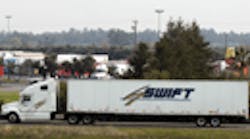The Arizona Supreme Court has ruled that drivers who filed suit against Swift Transportation (NYSE: SWFT) for allegedly “shorting” their pay may take the case to trial.
The past and present drivers in the lawsuit claim Swift “uses an artificial calculation that results in drivers being paid for significantly fewer miles than they actually drive,” according to their legal counsel, Seattle-based Hagens Berman Sobol Shapiro LLP.
Hagens Berman said the case can now move forward “because the Arizona Supreme Court has declined to review a trial court’s decision to certify a broad class action based on a 2008 appellate court decision that was vacated, which means the case will now proceed to trial.”
The law firm said the suit alleges Swift is guilty of breach of contract and breach of the implied covenant of good faith and fair dealing based on its alleged failure to pay for all miles driven.
“We are pleased that the court agreed with us that Swift drivers deserve to take this case to trial,” said Rob Carey, a partner in the Phoenix office of Hagens Berman. “We believe that the company illegally took millions in unpaid wages from its drivers.”
Carey said the complaint - originally filed on Jan. 30, 2004, in the County of Maricopa (AZ) Superior Court - charges specifically that “Swift short-changed drivers using a database that, on average, shorts drivers a significant percentage of their mileage - and hence their pay.”
“We believe that the software program chosen by Swift is not compatible with the company’s obligations under the drivers’ employment agreements,” he explained. “We look forward to pointing out this inconsistency in court and recovering drivers’ lost wages.”
As previously reported by Fleet Owner, the suit contends that Swift uses Rand McNally’s Household Goods Mileage Guide to determine miles driven for pay calculations. That guide, according to Hagens Berman, does not accurately reflect the miles actually driven and as such, Swift may have and may continue to underpay drivers between 6 and 10%. According to the law firm, although Swift uses software to calculate per-mile pay, it is “our understanding it does not use GPS point-to-point data.”
Hagens Berman has also noted that comparing one driver's actual miles driven to the miles paid for by Swift “show(s) the company reducing trips by up to 140 miles when paying the trucker.” The law firm said Swift “used this shortchanging practice for several years, and other major trucking companies may also have engaged in this unfair, illegal tactic. “
Further, Hagens Berman has stated it “seeks to hold Swift and any other companies involved responsible for repaying each driver fair compensation for the actual miles driven vs. the low figures utilized by the company's formula.”
The case has had its ups and downs moving through the Arizona court system over the past eight years. A Maricopa County judge initially denied the plaintiffs’ attempts to make it a class-action suit. That ruling was overturned by the Arizona Court of Appeals. Next, Swift appealed the Court of Appeals ruling to the Arizona Supreme Court, which overturned the decision to make it a class-action suit based on procedural grounds, saying the appellate court lacked jurisdiction to review the lower court’s ruling.
Then, back in Maricopa County Superior Court, the lead plaintiff, Leonel Garza, and the other plaintiffs filed a new motion to give the suit class-action status and the court agreed.
That Arizona judge ruled that the class of drivers represented includes “all persons in the United States, including those who were employed by Swift as employee drivers on or after Jan. 30, 1998, or contracted with Swift as owner-operator drivers on or after Jan. 30, 1998, who were compensated by Swift by reference to miles driven.” A subclass, defined as “all persons who contracted with Swift Transportation with a Contractor Agreement East Coast as of Dec. 14, 2001” was also declared.
According to Hagens Berman, the class size could amount to 20,000 to 30,000 drivers.




